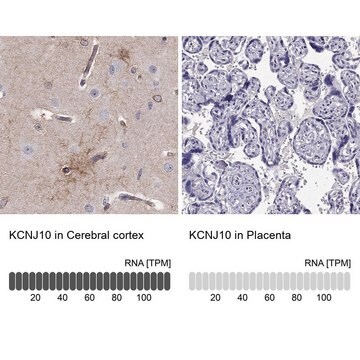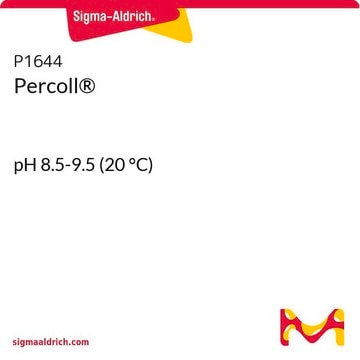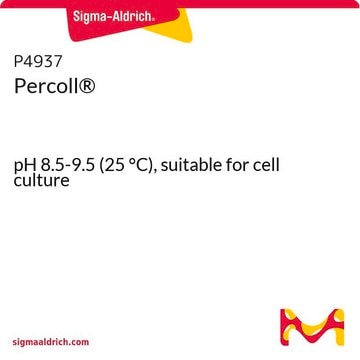推荐产品
生物源
mouse
共軛
unconjugated
抗體表格
purified immunoglobulin
抗體產品種類
primary antibodies
無性繁殖
1C11, monoclonal
形狀
buffered aqueous solution
物種活性
human
技術
indirect ELISA: suitable
western blot: 1-5 μg/mL
同型
IgG2aκ
GenBank登錄號
UniProt登錄號
運輸包裝
dry ice
儲存溫度
−20°C
目標翻譯後修改
unmodified
基因資訊
human ... KCNJ10(3766)
一般說明
Kir4.1/KCNJ10 (potassium voltage-gated channel subfamily J member 10) is an inwardly rectifying potassium (K+) channel. This gene is expressed in the brain, inner ear and kidney. KCNJ10 gene is mapped to human chromosome 1q23.
This gene encodes a member of the inward rectifier-type potassium channel family, characterized by having a greater tendency to allow potassium to flow into, rather than out of, a cell. The encoded protein may form a heterodimer with another potassium channel protein and may be responsible for the potassium buffering action of glial cells in the brain. Mutations in this gene have been associated with seizure susceptibility of common idiopathic generalized epilepsy syndromes. (provided by RefSeq)
免疫原
KCNJ10 (NP_002232, 276 a.a. ~ 379 a.a) partial recombinant protein with GST tag. MW of the GST tag alone is 26 KDa.
Sequence
DFELVLILSGTVESTSATCQVRTSYLPEEILWGYEFTPAISLSASGKYIADFSLFDQVVKVASPSGLRDSTVRYGDPEKLKLEESLREQAEKEGSALSVRISNV
Sequence
DFELVLILSGTVESTSATCQVRTSYLPEEILWGYEFTPAISLSASGKYIADFSLFDQVVKVASPSGLRDSTVRYGDPEKLKLEESLREQAEKEGSALSVRISNV
應用
Monoclonal Anti-KCNJ10 antibody has been used in immunohistochemistry.
生化/生理作用
Kir4.1/KCNJ10 (potassium voltage-gated channel subfamily J member 10) helps to regulate the basolateral K+ conductance in the DCT (distal convoluted tubule). It participates in the K+ spatial buffering process, that helps to maintain the resting membrane potential of neurons. Kir4.1 is essential for producing the endocochlear potential of intermediate cells and for retaining high K+ content of the endolymph in ear. In the eye, Kir4.1 plays a vital role in the modulation of the extracellular K+ level and in controlling the healing process of cornea epithelial cells. Mutations in KCNJ10 results in SeSAME (seizures, sensorineural deafness, ataxia, mental retardation and electrolyte imbalance).
外觀
Solution in phosphate buffered saline, pH 7.4
法律資訊
GenBank is a registered trademark of United States Department of Health and Human Services
免責聲明
Unless otherwise stated in our catalog or other company documentation accompanying the product(s), our products are intended for research use only and are not to be used for any other purpose, which includes but is not limited to, unauthorized commercial uses, in vitro diagnostic uses, ex vivo or in vivo therapeutic uses or any type of consumption or application to humans or animals.
Not finding the right product?
Try our 产品选型工具.
儲存類別代碼
10 - Combustible liquids
閃點(°F)
Not applicable
閃點(°C)
Not applicable
個人防護裝備
Eyeshields, Gloves, multi-purpose combination respirator cartridge (US)
Seizures, sensorineural deafness, ataxia, mental retardation, and electrolyte imbalance (SeSAME syndrome) caused by mutations in KCNJ10
Scholl UI, et al.
Proceedings of the National Academy of Sciences of the USA, 106(14), 5842-5847 (2009)
The expression, regulation, and function of Kir4.1 (Kcnj10) in the mammalian kidney
Su XT and Wang WH
American Journal of Physiology: Renal Physiology, 311(1), F12-F15 (2016)
Differential loss of KIR4.1 immunoreactivity in multiple sclerosis lesions
Schirmer L, et al.
Annals of Neurology, 75(6), 810-828 (2014)
Unidirectional photoreceptor-to-Muller glia coupling and unique K+ channel expression in Caiman retina
Zayas-Santiago A, et al.
PLoS ONE, 9(5) (2014)
John J Kelly et al.
Journal of cell science, 132(2) (2018-12-19)
Mutations in the genes that encode the gap junction proteins connexin 26 (Cx26, encoded by GJB2) and Cx30 (GJB6) are the leading cause of hereditary hearing loss. That said, the Cx30 p.Ala88Val (A88V) mutant causes Clouston syndrome, but not hearing
我们的科学家团队拥有各种研究领域经验,包括生命科学、材料科学、化学合成、色谱、分析及许多其他领域.
联系技术服务部门








